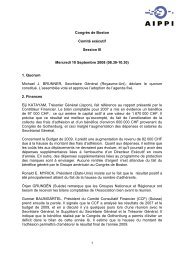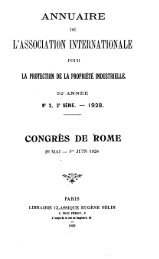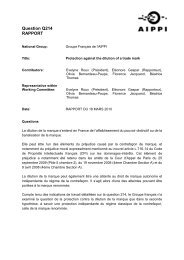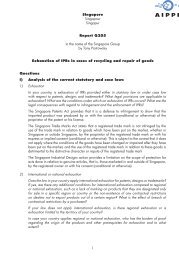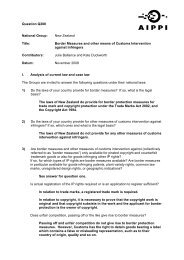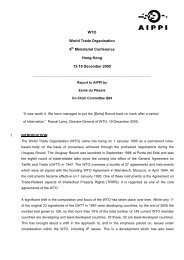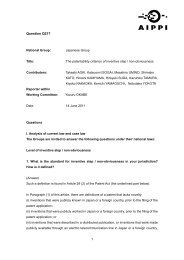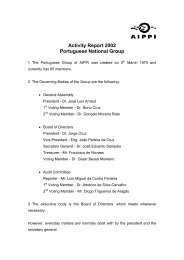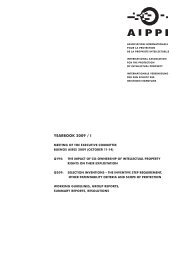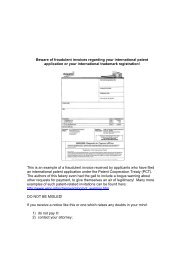Question Q234 National Group: Australia Title: Relevant ... - AIPPI
Question Q234 National Group: Australia Title: Relevant ... - AIPPI
Question Q234 National Group: Australia Title: Relevant ... - AIPPI
Create successful ePaper yourself
Turn your PDF publications into a flip-book with our unique Google optimized e-Paper software.
<strong>Question</strong> <strong>Q234</strong><br />
<strong>National</strong> <strong>Group</strong>:<br />
<strong>Australia</strong><br />
<strong>Title</strong>:<br />
<strong>Relevant</strong> public for determining the degree of<br />
recognition of famous marks, well-known<br />
marks and marks with a reputation<br />
Contributors:<br />
Clare Cunliffe, Nicholas Butera<br />
Reporter within<br />
Working Committee:<br />
Clare Cunliffe<br />
Date: 10 May 2013<br />
I. Analysis of current law and case law<br />
1) How is the relevant public for purposes of determining the degree of recognition<br />
of famous, well-known and reputed marks defined in your jurisdiction? Is it the<br />
general public at large or a relevant sector of the public that is considered to be<br />
the relevant public in determining the knowledge, recognition or fame of a mark?<br />
The term “famous” is not used in <strong>Australia</strong>n trade mark law.<br />
The term “well-known” is used in the Trade Marks Act 1995 (Cth) (the TMA) and<br />
in case law, as is the term “reputation”. As noted below, “notorious” is<br />
sometimes used by courts to characterise certain trade marks.<br />
The degree of recognition of a mark (including notorious marks, well-known<br />
marks and marks with a reputation) arises at several stages — registration,<br />
opposition, infringement and cancellation –as described below.<br />
Registration<br />
At the registration stage, reputation can be relevant to issues of whether use of<br />
the trade mark would be contrary to law (section 42(b) of the Trade Marks Act<br />
1995 (Cth) (TMA)); or whether the trade mark is substantially identical with or<br />
deceptively similar to a trade mark or trade mark application in respect of similar<br />
goods or closely related services (section 44 of TMA), although the term<br />
“reputation” is not used in these sections.<br />
8747904/3
Reputation is also relevant in determining whether the trade mark is capable of<br />
distinguishing the applicant’s goods or services (s 41 of TMA).<br />
Section 41<br />
The issue of reputation may be relevant to the issue of determining whether a<br />
mark has acquired distinctiveness.<br />
Section 42(b)<br />
Although section 42(b) is rarely invoked by the Trade Marks Office in the<br />
registration process, use of a trade mark will be contrary to law if it would<br />
constitute misleading or deceptive conduct contrary to section 18 of the<br />
<strong>Australia</strong>n Consumer Law (ACL), or the making of false or misleading<br />
statements contrary to s 29 of the ACL, or passing off.<br />
<br />
<strong>Australia</strong>n Consumer Law: In considering whether a case of<br />
misleading or deceptive conduct or passing off would be made out, the<br />
court will consider whether the applicant has established a reputation in<br />
the marks which would be appropriated by the respondent. Recent case<br />
law indicates that in determining whether use of a mark will breach the<br />
ACL, the court will consider whether a significant proportion of the<br />
general public will be confused by the use, not whether the target market<br />
for the impugned product will be confused (although reputation and<br />
confusion amongst the target market may suffice to establish sufficient<br />
reputation and deception among the general public). 1<br />
<br />
Section 44<br />
Passing Off: In considering whether use of a mark would constitute<br />
passing off, the party asserting its reputation must establish that it had<br />
the requisite reputation in the name or goods in the jurisdiction and that<br />
there is a likelihood of deception among consumers or potential<br />
consumers resulting from the respondent’s actions. This test appears to<br />
be directed at assessing the reputation amongst relevant consumers, not<br />
the general public. 2<br />
In determining substantial identity or deceptive similarity under s 44, it appears<br />
from references to “judicial notice” and “consumers generally” in the case law<br />
that the relevant reputation must be among the general public at large for a mark<br />
to be considered “notoriously ubiquitous”. 3<br />
1<br />
Hansen Beverage Company v Bickfords (<strong>Australia</strong>) Pty Ltd [2008] FCAFC 181 (Hansen).<br />
2<br />
This requires an applicant to prove that there are, within the relevant jurisdiction, a substantial number of persons<br />
who were aware of the applicant’s name or product and are possible consumers. It is necessary to show in a<br />
practical and business sense a sufficient reputation in the forum and this requires an evaluation of the size and<br />
distribution of the population of prospective consumers likely to be affected. See ConAgra Inc v McCain Foods<br />
(Aust) Pty Ltd [1992] FCA 159 and the discussion in Hansen (ibid).<br />
3<br />
“Where an element of a trade mark has a degree of notoriety or familiarity of which judicial notice can be taken ...<br />
[the element of the applied for mark] cannot be assessed without a recognition of its notorious familiarity to<br />
consumers.”: Registrar of Trade Marks v Woolworths [1999] FCA 1020, [50] (French J) (Woolworths). In<br />
8747904/3 page 2
Opposition<br />
Trade marks can be opposed on any of the grounds for which an application for<br />
registration may be rejected, including sections 41, 42 and 44 (set out above).<br />
Reputation is also central to the operation of the section 60 ground of opposition,<br />
which allows a person to challenge the proposed registration of a trade mark on<br />
the basis that, because another trade mark had “acquired a reputation in<br />
<strong>Australia</strong>” before the priority date of the applied-for trade mark, use of the<br />
applied-for trade mark would be likely to deceive or cause confusion.<br />
The reputation required in relation to section 60 is a reputation in relation to the<br />
goods or services the subject of the impugned mark application. It appears that<br />
section 60 does not require a reputation amongst any particular proportion or<br />
number of the <strong>Australia</strong>n population, but that a “significant” or “substantial”<br />
number of people or potential customers is required. 4 If the mark has a<br />
reputation among a highly knowledgeable group of consumers, it may be more<br />
difficult to demonstrate confusion. 5<br />
If a mark is notoriously ubiquitous amongst the general public (sometimes<br />
referred to in the opposition/infringement context as “very famous”), this<br />
reputation can serve both as a help and a hindrance. For example, if a mark is<br />
very famous, it may be easier to show that consumers would be confused by<br />
use of a similar mark in relation to goods/services other than those for which the<br />
mark has that reputation (brand extension). Examples in the <strong>Australia</strong>n context<br />
include Viagra/Herbagra (opposition) 6 , Huggies/”Huggie” Mummy (opposition) 7<br />
and the use of a Coca-Cola bottle shape for confectionary (infringement). 8<br />
However, as the reputation of a notoriously ubiquitous mark is a relevant<br />
consideration in determining deceptive similarity, 9 the very fame of that mark<br />
may mean that there is no imperfect recollection by the general public, and<br />
therefore no confusion with a similar mark in relation to similar goods to those for<br />
the famous mark has a reputation. This occurred in the infringement context in<br />
Mars v Sweet Rewards, where the Federal Court held that people would not<br />
Henschke, the Full Court of the Federal Court (in obiter) restricted the proposition expressed in Woolworths as<br />
follows “[I]n assessing the nature of a consumer’s imperfect recollection of a mark, the fact that the mark, or<br />
perhaps an important element of it, is notoriously so ubiquitous and of such long standing that consumers<br />
generally must be taken to be familiar with it and with its use in relation to particular goods or services is a<br />
relevant consideration.”C A Henschke & Co v Rosemount Estates Pty Ltd [2000] FCA 1539, [52]. (Henschke).<br />
4<br />
Tivo Inc v Vivo International Corporation Pty Ltd [2012] FCA 252 (Tivo).<br />
5<br />
Tivo ibid.<br />
6<br />
Pfizer Products Inc v Karam [2006] FCA 1663 (opposition to use of Herbagra in relation to “herbal medicines used<br />
to aid health, vitality and sexuality” due to reputation of Viagra).<br />
7<br />
Kimberly-Clark Worldwide, Inc v Goulimis [2008] FCA 1415 (opposition to use of “Huggie” Mummy for Direct<br />
selling of baby-toddler’s toys, videos, CD’s, books, games and accessories“ in light of reputation of Huggies for<br />
various baby products).<br />
8<br />
Coca-Cola Co v All-Fect Distributors Ltd [1999] FCA 1721.<br />
9<br />
Crazy Ron’s Communications Pty Ltd v Mobileworld Communications Pty Ltd [2003] FCA 901, [90].<br />
8747904/3 page 3
confuse the famous mark “Maltesers” for confectionary products with the mark<br />
“Malt Balls” for the same products. 10<br />
Infringement<br />
Reputation is specifically relevant in assessing infringement under section<br />
120(3) of the TMA, but it is also relevant in relation to determining whether the<br />
infringing mark is “deceptively similar” to the registered mark (as discussed<br />
above in relation to opposition).<br />
Section 120(3)<br />
Section 120(3) provides that a person infringes a registered trade mark if:<br />
<br />
<br />
<br />
<br />
the trade mark is well known in <strong>Australia</strong>;<br />
the person uses as a trade mark a sign that is substantially identical<br />
with, or deceptively similar to the trade mark in relation to:<br />
<br />
<br />
goods that are not of the same description as that of the<br />
goods in respect of which the trade mark is registered or are<br />
not closely related to services in respect of which the trade<br />
mark is registered; or<br />
services that are not of the same description as that of the<br />
registered services or are not closely related to registered<br />
goods; and<br />
because the trade mark is well known, the sign would be likely to be<br />
taken as indicating a connection between the unrelated goods or<br />
services and the registered owner of the trade mark; and<br />
for that reason, the interests of the registered owner are likely to be<br />
adversely affected.<br />
Section 120(4) of the TMA provides that in deciding whether a trade mark is well<br />
known in <strong>Australia</strong>, one must take account of the extent to which the trade mark<br />
is known within the relevant sector of the public, whether as a result of the<br />
promotion of the trade mark or for any other reason.<br />
Other causes of action (including cancellation)<br />
An owner of a mark with reputation or a well known mark may apply to cancel<br />
other trade marks under s 88(2) (which provides inter alia that marks can be<br />
cancelled on any ground on which they could be opposed, or because use of the<br />
trade mark is likely to deceive or cause confusion because of the circumstances<br />
applying at the time when the application for rectification is filed). 11<br />
An owner of a well known mark or reputed mark may also bring an action under<br />
the ACL or for passing off (including in relation to unregistered marks).<br />
10<br />
Mars <strong>Australia</strong> Pty Ltd v Sweet Rewards Pty Ltd [2009] FCA 606, [97].<br />
11<br />
We note that the ACL and passing off claims are the only protections available for the infringement of<br />
unregistered marks with a reputation in <strong>Australia</strong>.<br />
8747904/3 page 4
2) Please clarify whether your jurisdiction uses several of the terms discussed in<br />
sections 22–26. If so, is the “relevant public” construed differently when<br />
determining the recognition of famous marks, well-known marks and marks with<br />
reputation respectively (and, if applicable, marks subject to another term)? Is the<br />
assessment made based on the same criteria?<br />
<strong>Australia</strong>n trade mark law makes use of the following terms in the following<br />
contexts:<br />
<br />
<br />
<br />
<br />
Registration: Case law provides that if a mark has achieved notorious<br />
ubiquity or familiarity it may be registered even if there are earlier<br />
similar marks on the register. 12 While there is no clear guidance on “a<br />
degree of notoriety or familiarity”, the requirement that it be notorious<br />
enough for judicial notice to be taken indicates that the mark needs to<br />
have this degree of notoriety or familiarity amongst the general public.<br />
Opposition: The statute and case law in relation to s 60 (whether<br />
another trade mark has acquired a reputation in <strong>Australia</strong> before the<br />
priority date which would mean that the use of the opposed mark would<br />
be likely to deceive or cause confusion) refers to “a mark with a<br />
reputation in <strong>Australia</strong>”.<br />
In relation to s 60, the reputation must be proved “in respect of particular<br />
goods or services” for which the opposed trade mark is to be registered.<br />
The reputation needs to be amongst a “significant” or “substantial”<br />
number of people or potential customers bur does not require a<br />
reputation amongst any particular proportion or number of the <strong>Australia</strong>n<br />
population. A niche reputation may be taken into account in assessing<br />
whether reputation exists.<br />
Infringement: Section 120(3) of the Trade Marks allows a registered<br />
trade mark owner to sue for trade mark infringement where the<br />
registered trade mark “is well-known in <strong>Australia</strong>”. Section 120(4) states<br />
that in assessing whether a mark is well known, it is necessary to have<br />
regard to “the extent to which the trade mark is known within the relevant<br />
sector of the public, whether as a result of the promotion of the trade<br />
mark or for any other reason”. There is no authoritative case law on the<br />
section so it is unclear how the relevant public will be defined.<br />
Other causes of action Whether a mark has a reputation in <strong>Australia</strong> is<br />
also relevant in actions brought under the ACL for misleading and<br />
deceptive conduct and for actions brought under the common law for<br />
passing off (and thereby to s 42(b) (by which marks must not be<br />
registered if their use is contrary to law) and s 88(2) (by which marks<br />
may be cancelled if their use is contrary to law)). Although reputation is<br />
not strictly required to make out a case under the ACL, practically it is<br />
impossible to prove that use of a mark will mislead or deceive unless<br />
reputation is established. As set out above, it appears that for the<br />
12<br />
Woolworths; Henschke.<br />
8747904/3 page 5
purpose of the ACL, the relevant public is the general public and for<br />
passing off, the relevant public is the target market.<br />
3) If the relevant public can be a limited sector of the public please respond (if<br />
applicable with reference to statutory provisions and/or case law) to the following<br />
questions<br />
(a) Please briefly describe the criteria for determining the relevant public. Is<br />
consideration taken e.g. to age, gender, geography, culture, groups with<br />
special interests, sophistication/skill of the consumer? Is consideration taken<br />
to the way the goods or services with the trade mark in question are<br />
marketed?<br />
Opposition Proceedings – s 60 “reputation”<br />
It appears from the case law that the likelihood of making out a case of<br />
confusion will depend on the interaction between the nature of the goods in<br />
relation to which the reputation is asserted and the nature of the goods or<br />
services which are the subject of the impugned registration or application.<br />
So for example, in relation to food products, case law has considered<br />
whether consumers of food products will be confused (and has disregarded<br />
a niche reputation amongst food industry specialists). 13 In relation to DVR<br />
players, the relevant public for establishing reputation was the general public<br />
and while the reputation of an earlier mark amongst enthusiasts was<br />
relevant to establishing such a reputation, the knowledgeable nature of<br />
these enthusiasts made it more difficult to make out a case of confusion. 14<br />
In relation to child care services, the court found that there was a reputation<br />
amongst people who were interested in child care and early learning centres<br />
(in other words, the consumers or potential consumers of the goods/services<br />
for which the mark was used), and that the use of the impugned mark was<br />
likely to cause confusion. 15<br />
Infringement Proceedings “well known mark”<br />
There is currently no detailed judicial guidance on whether a mark is well<br />
known. The only cases that have dealt with this issue have been<br />
interlocutory proceedings for injunctions pending a final hearing of the<br />
matter. 16 In these cases, the relevant public has been the<br />
13<br />
Renaud Cointreau v Cordon Bleu International Ltée [2001] FCA 1170 (Renard Cointreau).<br />
14<br />
Tivo.<br />
15<br />
Toddler Kindy Gymbaroo Pty Ltd v Gymboree Pty Ltd [2000] FCA 618. In that case, the relevant public was also<br />
defined by reference to a particular geographic location (the state of Victoria)<br />
16<br />
Nintendo Co Ltd v Care [2000] FCA 1538 (“SUPER MARIO”); Virgin Enterprises Ltd v Klapsas [2001] FCA 1502<br />
(“VIRGIN”); <strong>Australia</strong>n Associated Motor Insurers Ltd v <strong>Australia</strong>n Automotive Motor Inspection Centre Pty Ltd<br />
[2003] FCA 1088 (“AAMI” — well known <strong>Australia</strong>n insurance company); San Remo Macaroni Co Pty Ltd v San<br />
Remo Gourmet Coffee Pty Ltd [2000] FCA 1842 (“SAN REMO” — well-known <strong>Australia</strong>n pasta manufacturer)<br />
and Lone Star Steakhouse & Saloon v Zurcas [2000] FCA 29 (“LONESTAR”).<br />
8747904/3 page 6
consumers/potential consumers of the goods/services for which the “well<br />
known mark” is registered.<br />
(b) Would the relevant public be populated by actual/potential<br />
consumers/buyers of the products/services in question only or a larger<br />
public? Please explain how the delimitation is made.<br />
<br />
In considering whether a trade mark has such “notorious ubiquity” that it<br />
should be registered under s 44, regard will be had to the mark’s<br />
reputation in relation to the particular goods and services in relation to<br />
which it is used, but it appears that the relevant public is the general<br />
public;<br />
In considering whether a mark has acquired a reputation under s 60,<br />
reference is made in the case law to a substantial number of people in<br />
the general public (although a niche reputation may suffice to<br />
demonstrate such a reputation);<br />
<br />
<br />
<br />
There is no definitive case law as to the relevant public for the purpose<br />
of considering whether a mark is well known under s 120(3);<br />
Actions under the ACL will consider the effect of the use of the mark on<br />
the general public (which is relevant to ss 42 and 88 of the TMA); and<br />
Passing off requires reputation amongst consumers of the respondent’s<br />
goods and services.<br />
(c) Could the relevant public be composed of business/professional end<br />
consumers?<br />
The relevant public may be composed of business/professional end<br />
consumers if the nature of the goods/services in question means they are<br />
targeted at those particular consumers. This is apparent from recent case<br />
law in relation to the issue of whether use of a particular mark in relation to<br />
speciality goods would deceive or cause confusion. 17<br />
However, where a mark is opposed on the basis of the niche reputation of<br />
an earlier mark, the nature of the goods applied for may determine the<br />
extent to which a niche reputation will be taken into account in determining<br />
confusion. Where an opposed mark relates to fast moving consumer goods<br />
which are generally available, the relevant public is likely to be the general<br />
public, and it may be irrelevant that the goods have a reputation amongst a<br />
smaller group. 18<br />
17<br />
Idameneo (No 780) Ltd v Symbion Pharmacy Services Pty Ltd [2011] FCAFC 164 (Symbion).<br />
18<br />
Renaud Cointreau; Suntory Limited v Aktion Zahnfreundlich [1998] ATMO 44<br />
8747904/3 page 7
(d) Could the relevant public be composed of people in the trade of the goods or<br />
services in question, such as distributors, licensees and retailers?<br />
Case law supports the view that the relevant public may include people in<br />
the trade of the goods or services in question as well as end users of the<br />
goods and services, depending on the nature of the goods or services which<br />
are the subject of the registration. 19<br />
In considering whether use of a mark will be misleading or confusing, the<br />
issue of any deceptive resemblance between the respective marks must be<br />
considered from the viewpoint of the specialised consumer for those goods<br />
and services. 20<br />
In the case of determining whether a mark is “well-known” for the purposes<br />
of s 120(3) infringement proceedings, the express words of s 120(4) refer to<br />
the “relevant sector of the public” — therefore allowing for a mark to be “wellknown”<br />
within a specialised market such as persons in the trade rather than<br />
end users.<br />
(e) Could the relevant public be “mixed” in a sense that it is composed of<br />
persons involved in trade, professional/business end customers and private<br />
end customers?<br />
Yes, if the users of the goods and services would be mixed, the relevant<br />
public may be mixed.<br />
(f) How limited in terms of quantification can the relevant sector of the public be<br />
to constitute the relevant public? Is there a clear established “lowest level”?<br />
For opposition under s 60, it is necessary to prove that there is a reputation<br />
amongst a “significant” or “substantial number” of people (although this is not<br />
quantified, and case law indicates that a small class may constitute a<br />
substantial number). For actions under the <strong>Australia</strong>n Consumer Law and<br />
passing off, it is necessary to demonstrate that there are a substantial<br />
number of persons who may be misled or deceived (which in practical terms<br />
will require establishing reputation among a “substantial number” of<br />
people). 21<br />
19<br />
For example in the context of an opposition, in Ainsworth Game Technology Ltd v IGT (2011) 93 IPR 532, the<br />
Trade Marks Office was required to determine the relevant public in relation to goods including components for<br />
gaming machines, parts and accessories for gaming machines and computer hardware and software and<br />
networking systems for linking gaming machines. The Trade Marks Office held that the relevant public were the<br />
hotels, clubs or casinos that purchased the gaming machines and not the general public who used the<br />
machines. However, in relation to a registration for, among other things, entertainment in respect of gaming<br />
machines, the Trade Marks Office held the relevant public to be the segment of the adult population at large<br />
which makes use of gaming venues.<br />
20<br />
Symbion.<br />
21<br />
Tivo (in respect of s 60); Hansen<br />
8747904/3 page 8
(g) Is it possible to see any differences for different products/industry sectors in<br />
respect of the delimitation of the relevant public?<br />
The relevant public may vary according to the products or services which are<br />
the subject of the impugned registration.<br />
4) Are there any differences between the “relevant public” concept when assessing<br />
the recognition of trade marks in respect of e.g. dilution, free riding or when<br />
determining likelihood of confusion in infringement proceedings?<br />
It is unclear how the relevant public will be determined in the context of wellknown<br />
marks.<br />
To succeed in an action under <strong>Australia</strong>’s consumer protection law, the ACL, the<br />
applicant must establish that a significant proportion of the public will be misled<br />
or deceived (although that requirement may be satisfied if there is a niche<br />
reputation and there would be confusion among that group). To succeed in a<br />
case of passing off, the applicant must establish that potential consumers of the<br />
products will be misled or deceived by use of the impugned mark.<br />
Consumer protection and passing off actions have been successful in protecting<br />
marks such as “Nike” which are used on dissimilar products, such as personal<br />
hygiene products — see, for example, the decision of the High Court in<br />
Campomar Sociedad Limitada v Nike International Limited [2000] HCA 12.<br />
As noted above, the determination of the relevant public in opposition<br />
proceedings (judged by reference to the specification applied for) and<br />
infringement proceedings (judged by reference to the plaintiff’s specification),<br />
appears to allow for consideration of a niche reputation, provided that reputation<br />
is among a substantial number of people.<br />
5) When does the assessment of the relevant public come into play e.g. in<br />
registration matters, proceedings in respect of wrongful use such as free riding,<br />
dilution, infringement proceedings and opposition proceedings?<br />
See above.<br />
6) Is the relevant public determined by a test, a specific procedure or in some<br />
similar manner, or rather on a case-by-case basis? Please give a brief<br />
description of how the test or analysis is made.<br />
The relevant public is determined on a case-by-case basis based on the matters<br />
referred to above.<br />
8747904/3 page 9
II. Proposals for Harmonisation<br />
Is harmonisation desired? If yes, please respond to the following questions<br />
Yes, harmonisation is desirable.<br />
1) Is the general public at large or a particular sector of the public that should be<br />
considered as the relevant public in determining the knowledge, recognition or<br />
fame of a mark?<br />
In order to determine whether a mark “is a mark with a reputation”, reference<br />
should be had to the sector of the public which consumes the relevant<br />
goods/services.<br />
However, in determining whether a mark is a “well-known” or “famous” mark, the<br />
mark should be known or recognised by the general public.<br />
This should be a separate enquiry to whether use of the mark would be<br />
misleading or deceptive or confusing.<br />
2) Please briefly set out the criteria to be used when establishing the relevant<br />
public for determining the degree of recognition of famous marks, well-known<br />
marks and marks with a reputation.<br />
For “marks with a reputation”, the relevant public should be based on:<br />
<br />
<br />
the nature of the goods/services offered under or in relation to the<br />
reputed mark (particularly whether they are goods/services that are<br />
purchased by the general public or by a small section of the public, the<br />
trade channels for the goods/services, whether similar companies<br />
engage in brand extension etc); and<br />
the way in which the goods/services are marketed (particularly<br />
advertising expenditure and promotional activities, but also, if such<br />
evidence is led, the target audience of advertising/marketing<br />
campaigns).<br />
As noted above, for “well-known” or “famous” marks, the relevant public should<br />
be the general public (construed by reference to reasonable members of the<br />
general public).<br />
3) Should the relevant public be construed differently for famous marks, well-known<br />
marks or marks with a reputation? If so, please define the terms used and<br />
describe what criteria is to be used for the different types of marks.<br />
If the protection afforded to a “famous” or “well-known” mark is broader than that<br />
extended to a mark with a “reputation” (as suggested above), the criteria for a<br />
“famous” or “well-known” mark should be different than the criteria for a mark<br />
with a “reputation”, and should be based on reputation among the general<br />
public.<br />
4) Would it possible or desired to establish a test or a specific method of<br />
establishing the relevant public or should this be done on a case-by-case<br />
assessment? How should the test or analysis be made?<br />
8747904/3 page 10
A case by case approach is most appropriate.<br />
III.<br />
Other Comments<br />
N/A<br />
Summary<br />
<strong>Australia</strong>n trade mark law recognises marks with “notorious ubiquity”, “well-known”<br />
marks and marks “with a reputation in <strong>Australia</strong>”.<br />
A mark is a “notoriously ubiquitous” mark if it is “notoriously familiar” amongst the<br />
general public at large. A “notoriously ubiquitous” mark is not likely to be confusingly<br />
similar to another mark because of its reputation — this can be useful in the registration<br />
and opposition (brand extension) contexts, but harmful for proprietors of “notoriously<br />
ubiquitous” marks seeking to prove infringement.<br />
Section 60 of the Trade Marks Act allows a person to oppose the registration of a trade<br />
mark if it is confusingly similar to a mark that has “acquired a reputation in <strong>Australia</strong>”.<br />
This reputation must be proved “in respect of particular goods or services” for which the<br />
opposed mark is to be registered, and needs to be amongst a “significant” or<br />
“substantial” number of people or potential customers. The relevant public is assessed<br />
on a case-by-case basis, as the determination of the number of potential customers and<br />
the members of the field of potential customers (which can include<br />
business/professional end consumers and people in the trade) is dependent on the<br />
nature of the relevant goods and services. A niche reputation is therefore sufficient in<br />
some circumstances.<br />
Section 120(3) allows the owner of a registered trade mark that is “well-known in<br />
<strong>Australia</strong>” to bring an infringement action against a person who uses as a trade mark a<br />
substantially identical or deceptively similar sign in respect of unrelated goods or<br />
services. Section 120(4) specifically states that a mark may be well-known within “the<br />
relevant sector of the public”. There is currently no authoritative guidance on what is<br />
meant by “the relevant sector of the public”.<br />
Under the <strong>Australia</strong>n Consumer Law, the plaintiff must establish that a significant<br />
proportion of the general public know the plaintiff’s mark and would be misled or<br />
deceived by the defendant’s use of it. Under the tort of passing off, the plaintiff must<br />
establish that the potential consumers of the defendant’s products would be misled or<br />
deceived by the defendant’s conduct because of the reputation of the plaintiff’s mark.<br />
8747904/3 page 11



